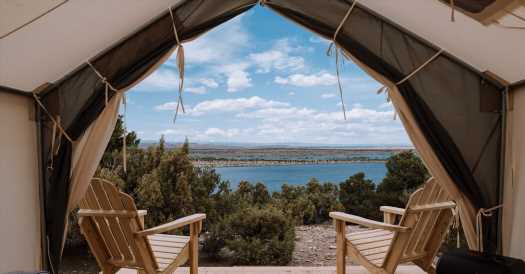
How to Reserve a Campsite, Even at the Last Minute
04/24/2021Pretend it’s a Monday in midsummer. You live in or near a big city, a few hours from mountains or forests, and you want to go camping this coming weekend — a few days away. Before the pandemic, that may have been possible. But these days the outdoors and camping are having their biggest boom since humans lived in caves, and finding a last-minute campsite is about as hard as spotting wild glowing mushrooms.
“With the onset of Covid, it seems as though everyone went out and bought an R.V.,” said Greg Query, owner of a Kampgrounds of America (KOA) campground in Estes Park, Colo., on the outskirts of Rocky Mountain National Park.
Public and private campgrounds were already seeing nationwide campsite shortages before Covid-19 because of a growing interest in outdoor activities. A 2019 North American Camping Report, from KOA, found that 7.2 million households in the United States started camping in the previous five years, bringing the total number to 78.8 million, a new high.
Many of those campers headed straight to national parks: A study from the research organization Resources for the Future in 2018 found that national park campsite reservations routinely are snatched up six months in advance, and places like Zion and Yosemite National Parks are frequently at 100 percent capacity.
The pandemic brought an influx of people looking to get away from it all. A May 2020 study from KOA reported that one-third of recreational travelers who had never camped before were interested in camping, many of whom are expected to return this summer.
“Campgrounds across the country near popular spots are going to be heavily booked this summer,” Mr. Query said. “Luck is going to play a big factor in whether or not you get a campsite for the weekend.”
So, what to do if you get a last-minute urge to camp near, say, San Francisco? Sure, popular campgrounds at Yosemite National Park or Big Sur are entirely booked (and have been for months). But all is not lost — the outdoors is not closed.
Hipcamp — which works with mostly private landowners to rent campsites on everything from ranches to vineyards — added 6,500 campsites across the United States to its booking site this March alone, and it recently partnered with California State Parks to show real-time availability data at state-run campgrounds.
“I’m not the kind of person who books campsites six months in advance. That’s why I started Hipcamp,” said Alyssa Ravasio, founder and the chief executive of Hipcamp. “Often, we’ll have a campsite for you that just got created in the last few months. We have these incredible properties just opening up.”
So, if you want to camp this weekend, but didn’t reserve a site in November, it’s still possible to sleep under the stars. Here’s how, in an easy step-by-step process.
Don’t forget about private campgrounds.
Step 1: Go online and search for last-minute campsites on both public and private land. Reserve America and recreation.gov hold the keys to most state and federally managed campgrounds. If the site you want is booked, look for recommended campgrounds nearby.
Don’t overlook privately owned campgrounds like KOAs or landowners who rent their land to campers on Hipcamp, Tentrr or Harvest Hosts. Though you can’t book spots directly, Campendium and The Dyrt show campsites via handy maps — everything from family-owned R.V. parks to state parks to legal dispersed camping zones in the area you’re hoping to go.
Another private-land option is glamping — think canvas tents, tree-houses or vintage trailers — that offer outdoor spaces and rustic accommodations, as well as a comfy bed and hot showers. GlampingHub, Campspot or Airbnb (search “unique stays” like yurts or dome houses under filters) are good places to start. Or check out the multiple locations across the country of glamping resorts like Under Canvas, AutoCamp or Wander Camp.
“You can find some cool and creative lodging that gives you the feel of being at a campsite, with hammocks and outdoor fire pits, but with a few extra amenities,” said Chaya Harris, program director at Outdoor Afro, a community network for Black Americans that organizes camping and other outdoor activities. “It’ll still feel like an adventure and there’s more availability.”
Look for first-come-first-served sites.
Let’s say you struck out with booking a last-minute private-land spot to pitch a tent. That’s OK. Next up, looking for campsites that can’t be reserved ahead of time. Many state parks and some national park campgrounds maintain a number of first-come-first-served sites that are held for walk-up users on the day of.
RVShare, a peer-to-peer R.V. rental site, keeps a list of first-come-first-served campsites around the country. Or book a deluxe camper van rental from Moterra, which has four pickup locations around the West, or from Vermont Adventure Vans, out of Burlington. Those van outfitters can often help with custom trip planning; they may be able to recommend first-come-first-served campsites along your route.
Once you find a campground that doesn’t take reservations, keep it in mind for future last-minute trips. For instance, the 10 public campgrounds on Tioga Pass (including Tioga Lake Campground and Saddlebag Lake Campground) outside the lesser-visited Tuolumne Meadows entrance to Yosemite National Park do not take reservations.
Neither does the riverfront Salmon River Campground near Stanley, Idaho, or the lakefront Dockery Lake Campground in Dahlonega, Ga., less than two hours from Atlanta. All of the backcountry shelters run by the Appalachian Mountain Club in the White Mountains of New Hampshire are also first come first served.
Most of these no-reservation spots in popular areas fill up in the morning, so get there early and plan to wait around until a site is vacant. “If you have flexibility, come midweek or come early in the day,” said Ms. Harris, of Outdoor Afro. “Show up on a Friday afternoon and you’ll just spend the evening driving around in circles looking for a spot.”
Skip the campground; go dispersed camping.
Dispersed camping means sleeping for free on public land managed by the Bureau of Land Management (B.L.M.) or the U.S. Forest Service. The B.L.M. has online maps and guidelines for how and where to camp on public lands. It’s not for everyone, and it’s not available everywhere. Be sure to read up on local land-use restrictions regarding camping and be familiar with “leave no trace” principles and area campfire regulations.
Campendium and Freecampsites.net list established sites where you can post up in the woods, with no fee and no reservations.
“If you want to find a place to camp and a way to get away from the crowds, there are millions of acres of B.L.M. and U.S. Forest Service land with legal camping and minimal services,” said Michael Lanza, creator of the trip-planning website TheBigOutside and a former field editor for Backpacker magazine. “You won’t get a picnic table, but you’ll still get a beautiful spot, and it’s free.”
Bear in mind that toilets, picnic tables, fire pits, running water, trash services — amenities usually available at a campground — aren’t on offer in the middle of nowhere.
Drive farther afield.
If none of those earlier options worked, you still have a few more last-ditch options: You can drive farther away or try your luck at a last-minute campsite cancellation. Case in point: While every campsite at Arches National Park in southern Utah may be booked, at Mesa Verde National Park, in southwest Colorado and about two hours from Arches, you can almost always find a spot.
“Our visitation numbers are a lot lower than a park like Arches. They get a few million visitors per year; we get 600,000,” said Spencer Burke, a park ranger at Mesa Verde National Park. “We have a big campground that always has last-minute availability. Working in the visitors’ center, people come in at the end of the day, and say, ‘Do you have any campsites available?’ It’s always nice to be able to say: ‘Yes. We have room for you.’”
Be willing to explore new, more obscure areas. The campgrounds inside Acadia National Park, in Maine, might be packed, but you can find an empty, remote camp spot within the 21,871 acres of Deboullie Public Land, five hours north. “Look for parks that are farther from population centers and airports,” Mr. Lanza said. “The farther away you are, the farther you are from other people.”
Cancellations happen, too. Often, campground websites don’t reflect real-time data on what’s actually available and, because cancellation policies differ, some campers don’t bother to cancel a reservation they no longer need. Even if the website shows no availability, you can always show up and ask the camp host if any sites are open. Better yet, give a call if a phone number is listed.
“I always recommend a phone call,” Mr. Query, from the Estes Park KOA, said. “Call the campground office to see if your luck might be working in your favor that day.”
If all else fails, and you can’t get a site for Friday night, you can always pitch a tent in the backyard or the living room. The s’mores still taste just as good there.
Follow New York Times Travel on Instagram, Twitter and Facebook. And sign up for our weekly Travel Dispatch newsletter to receive expert tips on traveling smarter and inspiration for your next vacation. Dreaming up a future getaway or just armchair traveling? Check out our 52 Places list for 2021.
Source: Read Full Article


